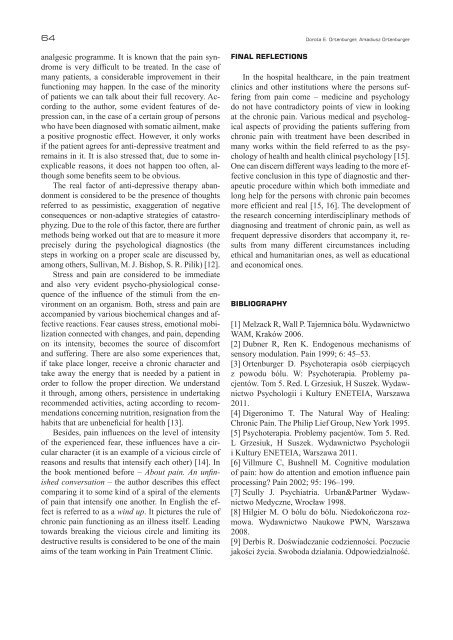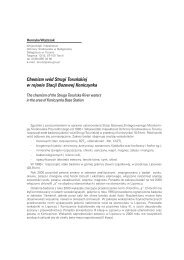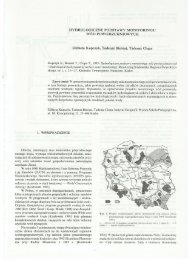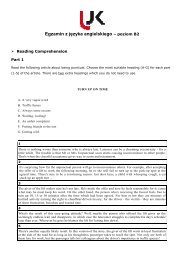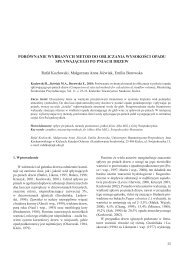25/2012 - Uniwersytet Jana Kochanowskiego w Kielcach
25/2012 - Uniwersytet Jana Kochanowskiego w Kielcach
25/2012 - Uniwersytet Jana Kochanowskiego w Kielcach
You also want an ePaper? Increase the reach of your titles
YUMPU automatically turns print PDFs into web optimized ePapers that Google loves.
64 Dorota E. Ortenburger, Arkadiusz Ortenburger<br />
analgesic programme. It is known that the pain syndrome<br />
is very difficult to be treated. In the case of<br />
many patients, a considerable improvement in their<br />
functioning may happen. In the case of the minority<br />
of patients we can talk about their full recovery. According<br />
to the author, some evident features of depression<br />
can, in the case of a certain group of persons<br />
who have been diagnosed with somatic ailment, make<br />
a positive prognostic effect. However, it only works<br />
if the patient agrees for anti-depressive treatment and<br />
remains in it. It is also stressed that, due to some inexplicable<br />
reasons, it does not happen too often, although<br />
some benefits seem to be obvious.<br />
The real factor of anti-depressive therapy abandonment<br />
is considered to be the presence of thoughts<br />
referred to as pessimistic, exaggeration of negative<br />
consequences or non-adaptive strategies of catastrophyzing.<br />
Due to the role of this factor, there are further<br />
methods being worked out that are to measure it more<br />
precisely during the psychological diagnostics (the<br />
steps in working on a proper scale are discussed by,<br />
among others, Sullivan, M. J. Bishop, S. R. Pilik) [12].<br />
Stress and pain are considered to be immediate<br />
and also very evident psycho-physiological consequence<br />
of the influence of the stimuli from the environment<br />
on an organism. Both, stress and pain are<br />
accompanied by various biochemical changes and affective<br />
reactions. Fear causes stress, emotional mobilization<br />
connected with changes, and pain, depending<br />
on its intensity, becomes the source of discomfort<br />
and suffering. There are also some experiences that,<br />
if take place longer, receive a chronic character and<br />
take away the energy that is needed by a patient in<br />
order to follow the proper direction. We understand<br />
it through, among others, persistence in undertaking<br />
recommended activities, acting according to recommendations<br />
concerning nutrition, resignation from the<br />
habits that are unbeneficial for health [13].<br />
Besides, pain influences on the level of intensity<br />
of the experienced fear, these influences have a circular<br />
character (it is an example of a vicious circle of<br />
reasons and results that intensify each other) [14]. In<br />
the book mentioned before – About pain. An unfinished<br />
conversation – the author describes this effect<br />
comparing it to some kind of a spiral of the elements<br />
of pain that intensify one another. In English the effect<br />
is referred to as a wind up. It pictures the rule of<br />
chronic pain functioning as an illness itself. Leading<br />
towards breaking the vicious circle and limiting its<br />
destructive results is considered to be one of the main<br />
aims of the team working in Pain Treatment Clinic.<br />
FINAL REFLECTIONS<br />
In the hospital healthcare, in the pain treatment<br />
clinics and other institutions where the persons suffering<br />
from pain come – medicine and psychology<br />
do not have contradictory points of view in looking<br />
at the chronic pain. Various medical and psychological<br />
aspects of providing the patients suffering from<br />
chronic pain with treatment have been described in<br />
many works within the field referred to as the psychology<br />
of health and health clinical psychology [15].<br />
One can discern different ways leading to the more effective<br />
conclusion in this type of diagnostic and therapeutic<br />
procedure within which both immediate and<br />
long help for the persons with chronic pain becomes<br />
more efficient and real [15, 16]. The development of<br />
the research concerning interdisciplinary methods of<br />
diagnosing and treatment of chronic pain, as well as<br />
frequent depressive disorders that accompany it, results<br />
from many different circumstances including<br />
ethical and humanitarian ones, as well as educational<br />
and economical ones.<br />
BIBLIOGRAPHY<br />
[1] Melzack R, Wall P. Tajemnica bólu. Wydawnictwo<br />
WAM, Kraków 2006.<br />
[2] Dubner R, Ren K. Endogenous mechanisms of<br />
sensory modulation. Pain 1999; 6: 45–53.<br />
[3] Ortenburger D. Psychoterapia osób cierpiących<br />
z powodu bólu. W: Psychoterapia. Problemy pacjentów.<br />
Tom 5. Red. L Grzesiuk, H Suszek. Wydawnictwo<br />
Psychologii i Kultury ENETEIA, Warszawa<br />
2011.<br />
[4] Digeronimo T. The Natural Way of Healing:<br />
Chronic Pain. The Philip Lief Group, New York 1995.<br />
[5] Psychoterapia. Problemy pacjentów. Tom 5. Red.<br />
L Grzesiuk, H Suszek. Wydawnictwo Psychologii<br />
i Kultury ENETEIA, Warszawa 2011.<br />
[6] Villmure C, Bushnell M. Cognitive modulation<br />
of pain: how do attention and emotion influence pain<br />
processing? Pain 2002; 95: 196–199.<br />
[7] Scully J. Psychiatria. Urban&Partner Wydawnictwo<br />
Medyczne, Wrocław 1998.<br />
[8] Hilgier M. O bólu do bólu. Niedokończona rozmowa.<br />
Wydawnictwo Naukowe PWN, Warszawa<br />
2008.<br />
[9] Derbis R. Doświadczanie codzienności. Poczucie<br />
jakości życia. Swoboda działania. Odpowiedzialność.


